Skinner is typically seen as an enemy of religion, and it’s true that he is not a particularly religious individual. Most of the reasoning for this comes from his views on free will and superstition. Skinner is not specifically an opponent of free will, like many past thinkers. He’s an opponent of will. Skinner believes, regardless of one’s belief in spirituality, God, or a soul, that any attempt to describe man as autonomous, aside from basic instincts, is incorrect at best and delusional at worst. As branches of Christianity are often reliant on free will to explain suffering, this causes problems among many believers.
Furthermore, behaviorism can explain prayer as superstition. Prayer, to Skinner, is always on a variable ratio reinforcement schedule; we see things happen that we prayed for, which makes us feel as if the prayer works. From a theological standpoint, there are all kinds of ways to nitpick this idea: First, we consider prayer to be asking God for help, not the direct source of help. Second, prayer is (for most people) two-way communication with God, not just a chance to ask for things. Third, most of us can tolerate an answer of “no” to our prayers without losing our faith.
But Skinner wasn’t looking to argue the merits of Christian theology. He’s just looking to explain behavior, as someone who is not a member of the Christian faith. Let’s suppose Skinner is correct, and that prayer, like all behavior, is the product of reinforcement or punishment. Obviously, few people are punished for praying, so we’ll leave that idea aside. Suppose, for a moment, that prayer is not supposed to be a variable ratio reinforcement schedule, but a fixed interval one. Consider how Jesus taught his disciples to pray in one is almost universally known as The Lord’s Prayer. Do you recall the one physical thing Jesus asks for?
“Give us this day our daily bread.”
Yet Jesus also spoke of how he knew God would care for him, as he even cared for birds: “Look at the birds of the air; they do not sow or reap or store away in barns, and yet your heavenly Father feeds them. Are you not much more valuable than they?” (Matthew 6:26, NIV)
Why would Jesus pray for something he knew he would receive? I would suggest that we aren’t only supposed pray for miracles, but for the things we know God already gives us. In this way, our prayers, in some way, are always answered. Our requests cease to be endless begging to God for things we may or may not need, and instead become a new means of appreciating what God gives us. All good things come from God.
I associate Skinner with redemption, not because of his anti-religious beliefs (obviously) but because of proven effectiveness of behavioral treatments and the way behaviorism forces Christians to consider the origins of their behavior and think critically about their beliefs.

